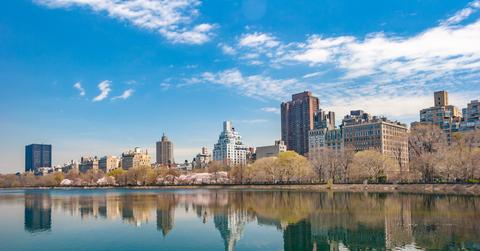Trees Can Reduce Energy Costs In Cities, New Study Shows
A study from the University of British Columbia has found that even one tree can help reduce energy costs in city buildings, and suggests foliage is likely a city's best line of defense against the chilling costs and effects of wind.
Updated May 17 2019, 8:53 p.m. ET
Even one tree can cut energy consumption in cities, according to a new study. What’s more, during winter months trees can reduce a building’s energy consumption by a shocking 10 percent, or 15 percent in the summer.
The report, called, “Effects of trees on mean wind, turbulence and momentum exchange within and above a real urban environment,” which was published in the journal Advances in Water Resources, takes a deep dive into how trees are likely the best lines of defense a city can have against the chilling effects (and utility costs) of wind.
Trees can cut wind speed in half.
Scientists from the University of British Columbia (UBC) used remote-sensing laser technology for the study in order to determine how trees affect wind velocity. First, a computer model of a Vancouver neighborhood was created. The mock-up took into account every single plant, building, tree, sidewalk and road. Then, a computer simulation ran through multiple scenarios (no trees, limbless trees, trees with dense foliage, etc.) to see how trees affect airflow from the wind. These hypotheticals were put up against a decade of wind data collected from the university’s research tower.
“We found that removing all trees can increase wind speed by a factor of two, which would make a noticeable difference to someone walking down the street,” Marco Giometto, who wrote the paper as a civil engineering postdoctoral fellow at the UBC, said in a release. “For example, a 15 km/h wind is pleasant, whereas walking in 30 km/h wind is more challenging.”
But trees do more than make walking more pleasant. They can totally change the impact of wind on buildings. Put some trees between a building and the prevailing wind, watch said consumption drop.
“Wind pressure is responsible for as much as a third of a building’s energy consumption,” Giometto said “Using our model, we found that removing all the trees around buildings drove up the building’s energy consumption by as much as 10% in winter and 15% in summer.”
Every branch of every tree makes a difference.
These savings aren’t measurable only for evergreens, either.
“Even bare branches play a role,” said Marc Parlange, who supervised the work while a professor of civil engineering at UBC, in a release. “Deciduous trees, which shed their leaves every year, reduce pressure loading on buildings throughout the year—it’s not only evergreens that are important in the city.”
And in North America, where trees can be quite large, even a lone tree can make a difference.
“In North American suburban areas, a single tree can be relatively large when compared to the typical building size, and can thus effectively shelter the building,” Giometto told Popular Science.
The study may help with storm preparedness and weather reporting.
UBC geography professor Andreas Christen, who co-authored the study, said it’s the first of its kind to create a simulation featuring an actual urban neighborhood. He pointed to the potential for research like this to educate weather forecasts and aid in emergency preparedness during heavy storms.
“Information from such models can improve weather forecasts in order to predict the effects of a storm on a building and pedestrian level,” Christen said in UBC’s press release. “It could also help city planners in designing buildings, streets, and city blocks to maximize people’s comfort and limit wind speed to reduce energy loss.”
Of course, while not part of the study, trees have been used for all these purposes in rural areas for ages. “The beneficial effects of trees in reducing wind speed was actually well-known by farmers before this study,” Giometto told Popular Science. “Now we have a tool to quantify it and help the design of future windbreaks to maximize their effects.”
